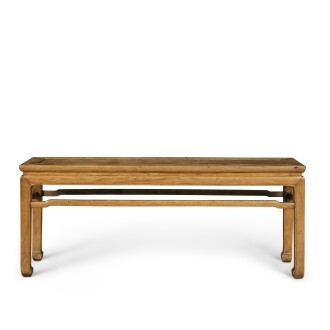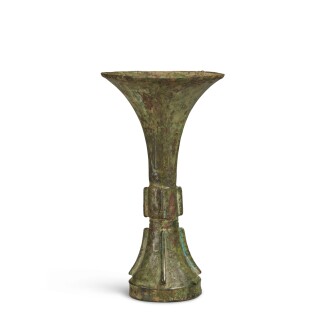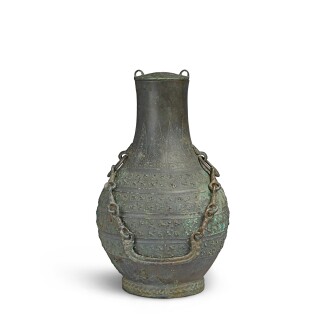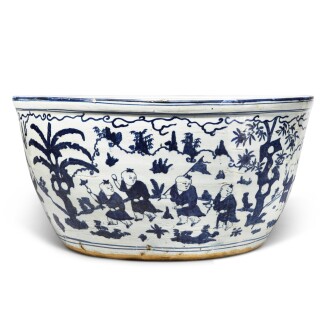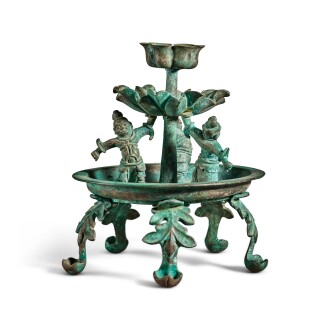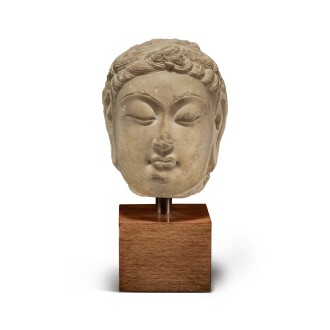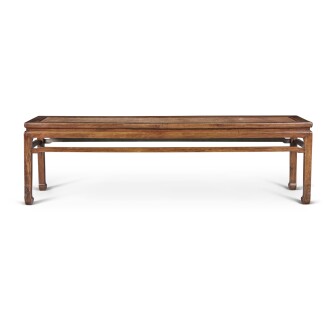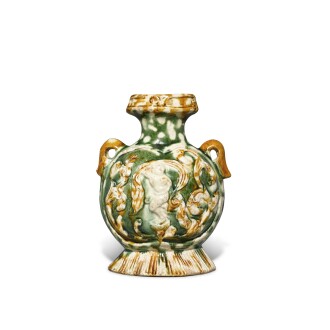S otheby’s is privileged to present a diverse assemblage of rare and exceptional Chinese archaic bronzes, jades, lacquer, ceramics, porcelain and other works of art from distinguished collections in September 2021, spanning 4000 years of Chinese history from the Shang dynasty to the Republic period. Highlights include a group of magnificent and important ritual bronzes from the MacLean Collection, and important Chinese art from the collection of Bruce Dayton and Ruth Stricker Dayton.

Sale Highlights

To compile a collection of Chinese archaic bronzes as comprehensive and varied as that of Barry MacLean is a remarkable feat. It is weapons and tools made of bronze that define the Bronze Age – as against the Stone or the Iron Age – but the repertoire of ancient China’s bronze casters was vast. To showcase their ingenuity and inventiveness is clearly what Barry MacLean had in mind, when he assembled this group. The classic ritual vessels and bells that were used in the ancestral ceremonies of the Shang (c.1600-1046 BC) and Zhou (1046-221 BC) dynasties always occupied an exalted position among China’s works of art; but as the collection aptly documents, bronze craftsmen equally devoted their care and creativity to the production of luxuries for daily use, musical instruments, as well as practical items.


J. Arthur MacLean (1879-1964) was a Curator, Lecturer and Collector of Asian works of art, who was instrumental in the formation of Asian art collections in several American museums. After having worked in the Oriental Department of the Museum of Fine Arts, Boston, he moved to the Cleveland Museum of Art, that had just been founded in 1913, became its first and sole Curator and Assistant to the Director, and later, in 1919, its first specialized Curator of Oriental Art. From there he came to the Art Institute of Chicago, where he was Assistant Director. He then served the John Herron Art Institute, Indianapolis, as Director, which later became the Indianapolis Museum of Art. He was a founding member of the Toledo Artists Club and became Asian Art Curator of the Toledo Museum of Art in 1927, where he remained until his retirement in 1945.
Throughout his career, MacLean was instrumental in establishing some of the foremost collections of Asian art in the U.S. and bringing public consciousness to Asian art and culture. The wugong in his collection encapsulates MacLean’s lifelong appreciation of East Asian works of art and testifies to the superb quality of art he was able to access and promulgate through his work.
“China in my estimation is a wonderful nation…It seems to me that it is the duty of those who have been to that land or of those who have given it study to make us realize how important the Chinese nation is.”

An exceptionally rare gold-ground famille-rose five-piece altar set (wugong), Seal marks and period of Qianlong | 清乾隆 金地粉彩纏枝蓮八吉祥紋五供一套 《大清乾隆年製》款
Estimate: 600,000 - 800,000 USD


There have been few art collectors more influential than Bruce Dayton (1918-2015) and Ruth Stricker Dayton (1935-2020). Longtime philanthropists and supporters of the Minneapolis Institute of Art (Mia), the Daytons’ immense generosity, impeccable eye, eclectic interests, and continual curiosity shaped the institution into one of the leading encyclopedic art collections in the US. Bruce and Ruth Dayton visited China more than a dozen times, and it was during these trips that they became, in their words, ’confirmed Sinophiles.’ Unlike most private collectors, who bought with their personal preferences in mind, the Daytons always considered the public audience. As Bruce Dayton once said, ‘I believe that one does not really own a work of art, but merely has the temporary possession of it and, hence, has a responsibility to find its highest or best use.’ Indeed, one would be hard pressed to find a higher or better collecting purpose than the Daytons’ commitment to philanthropy, civic duty, and reaching others through the power of art.
“We always have the museum audience in mind and seek to build collections that will speak to it of the wonders of China.”


Simon F. Rothschild was born in Eufaula, Alabama and was raised in Columbus, Georgia until his family moved to Manhattan in the 1870s. After graduating from the College of the City of New York with a degree in business, he worked for his grandfather’s manufacturing business before going on to co-found S. F. & A. Rothschild with his brother in 1887. Six years later, Rothschild partnered with Nathan Straus and Isidor Straus to buy out Joseph Wechsler's interest in the Brooklyn department store Wechsler & Abraham, which had been co-founded by Rothschild's father-in-law Abraham Abraham. Rothschild and the Strausses changed the store's name to Abraham & Straus.

As President of the company, Rothschild oversaw significant mergers with the department stores Filene's (Boston, MA), Lazarus (Columbus, OH), and Bloomingdale's (New York, NY) to form Federated Department Stores in 1929. Federated Department Stores survives to this day and is now known as Macy’s. Outside of work, Rothschild played a vital role in the commercial, cultural, and philanthropic development of Brooklyn. His interest in art led him to collect the Qing porcelains in the present sale. Walter Nathan Rothschild (1892-1960), followed in his father’s footsteps, becoming General Manager of Abraham & Strauss in 1925, President in 1937, and Chairman in 1955. Walter and Carola’s daughter, Phyllis Rothschild Farley (1942-2020) , was the third generation of the family to steward the Chinese porcelain collection.

A tribute from the Hui region,
this vessel was made meticulously with the precious materials in mind.
It was not a few groups of magpies,
there placed a pair of fish.
Who shall strike the jia of the hero,
a letter from a faraway guest is hard to find.
Zhong Fu (Inner Truth) is the manipulation of phenomenon,
I eagerly pursue the cultivation of moral virtues.
–Qianlong bingxu chun yuti

An extremely rare inscribed archaistic celadon jade 'twin fish' basin, Mark and period of Qianlong | 清乾隆 青玉雕雙魚盤 《大清乾隆倣古》款
Estimate: 200,000 - 300,000 USD

During the Qing dynasty, lacquer arts enjoyed a renaissance following their decline at the end of the Ming dynasty (1368-1644) and the intervening years. At both imperial and private workshops, craftsmen working in this medium achieved new heights in terms of virtuosity and scale of execution. The Qianlong Emperor commissioned numerous panels, often in pairs, to adorn the myriad halls built under his direction.


Liang Dunyan (1857–1924) was a native of Guangdong province, who was partially educated in the United States through his participation in the Chinese Educational Mission. As part of that pioneering program, Liang entered Hartford Public High School in Connecticut in 1874 and went on to graduate from Yale University (class of 1882). Following his return to China, Liang served in numerous important roles as a politician, diplomat, and advocate for education starting in the late Qing dynasty. Among his distinguished positions were his tenure as President of Beiyang University in Tianjin (1904-07), China’s Minister to the U.S.(stationed in Washington, D.C.) (1907), and the President of the Board of Foreign Affairs (1908-11). His prime accomplishment was negotiating with the U.S. Minister to China, William Rockhill, in 1908-09, to finalize the U.S.-Sino scheme to utilized the excess Boxer Indemnity funds in the creation of a Boxer Indemnity Scholarship. During the Republic period, Liang served as the Minister of Communications (1914-16) and as the Minister of Foreign Affairs (1917).

There are a handful of names in the world of Chinese art that are inextricably associated with works of exceptional quality. Stephen Junkunc, III is amongst these luminaries. The name itself is instantly evocative of a period during which some of the greatest Chinese treasures came to America. The Junkunc name today serves as one of the most important, and indeed desirable, provenances for Chinese art. Formed in America in the mid-20th century by Stephen Junkunc, III (d. 1978), the Junkunc Collection at its height numbered over 2,000 examples of exceptional Chinese porcelain, jade, bronzes, paintings and Buddhist sculptures; serving as a testament to a period of unprecedented wealth of Chinese material available in the West, as well as to an astounding intellectual curiosity and the means with which to buy internationally from the leading dealers in the field.

This important collection of snuff bottles and other Chinese works of art was formed over the course of three generations. Its contents were principally selected by the women in the family, and the collection as a whole has passed through the matriline. The majority of the pieces were purchased by Kenyon Vickers Painter, Sr. (1867-1940) and Leila Maud Wyeth Painter (1885-1971). Mr. Painter was born to a prominent Quaker family in Ohio, in which his pioneering mother, Lydia Ethel Farmer Painter (1842-1909), owner of the Cleveland & Pittsburgh Railroad Company, was an author, poet, avid traveller and had a fascination with East Asian philosophy.



















